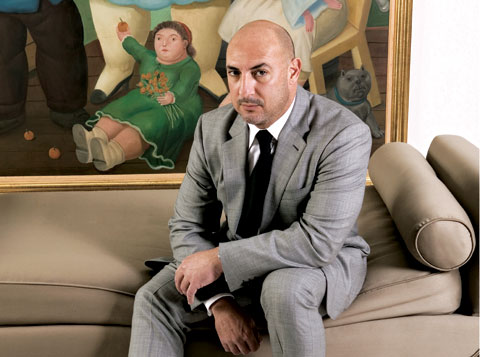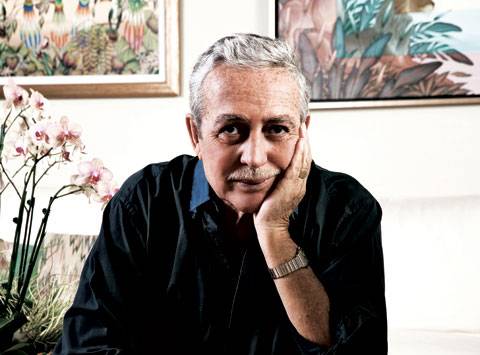Nader also champions charity. He’s opened up a foundation in Miami and the Dominican Republic to educate people and help them with teenage pregnancy.
I am in the largest gallery in the world. Within it’s 55,000 square feet there are 3,000-plus pieces, and outside there is a sculptural park. It’s in Miami, in Wynwood to be exact, but few people seem to be aware of this. I, however, know about Gary Nader Fine Art. When I was here almost 365 days ago to interview Gary Nader, as I was treated to the gallery’s seemingly unending cultural treasure trove, the art world was in the midst of vertiginous growth. Sales records were being reported daily as real estate execs and petrol dollar moguls were buying compulsively. But now dealers are reporting weaker sales, while hesitant buyers and fewer art fair visitors are taking a toll on the once untouchable art market. The bubble has finally burst. The frenzy that made art students stars overnight, spawned scores of fairs around the world, and turned young investment bankers into major collectors has come to an end. To which Nader, ever the iconoclast, responds, “Good.”
It’s a provocative position, but I’m not surprised. And neither is anyone else who read the Haute Living piece about him last year. He called it. He warned us. He tried to hammer home that the market was in a bloated bubble of dangerous overvaluation. He felt it was important to sound the alarm. Now he wants to help everyone understand the current economic situation as it pertains to art. “People think art is going to be devalued,” Nader starts. “Yet it’s been proven through many slowdowns or recessions that really good art is practically recession-proof. Major stock houses have lost between 30 and 45 percent. What’s amazing is that in spite of that, the past auctions have demonstrated that quality still sells.”
He’s right. In the last month, Basquiat went for $13.5 million. A Munch landed $38.16 million, and a Degas danced off with $37 million. Malevich commanded $60 million, while Renoir, Matisse, Magritte, and Toulouse-Lautrec have all sold within their multimillion estimates. So Nader isn’t stressed. “Last week I had lunch with Fernando Botero and Sophia Vari. Even though they were sad because of the world situation, they were relieved to know that the downturn will cleanse the market, like a hurricane. A lot of people have made mistakes buying what’s fashionable instead of what’s actually valuable. If you take a catalogue from 25 years ago, and then compare it with one from today, half the artists are no longer there. Auction houses have been extremely irresponsible in misleading people.”
Another problem also exists in the art world: anyone can open a gallery. Although it’s wonderfully democratic in theory, in practice it sets up dangerous, corrosive forces that impact the market. Simply put, you open a gallery, you’re a mouthpiece. An expert. “Then foolish people follow the gallery’s advice,” Nader laments. “And you see many galleries close today because there was no backbone, no principle or history. We were in a bonanza for the past 15 years in the art market. What is amazing and fantastic is that I called some major dealers of mine in New York, London, and Paris, and nobody is going out there to unload art. People come and ask, ‘Is there something great we can buy because of the recession?’ But there actually isn’t.” Important collectors are not selling their art, and thus there’s no flow in the market. Artists are still taking in incredible prices. But for Nader, the good part is that people are losing interest in the purely trendy. They’re getting back to what he feels is of supreme importance: an artist’s proven curriculum over time.
What is important is a big deal to Nader. It’s the backbone of everything he does. Take, for example, his work in the Middle East. He’s been going to Abu Dhabi and Dubai for the last couple of years to try and create more awareness and appreciation of art, and eventually build a modern museum. He’s proposing a sculptural park design to Oman, which is planning the first botanical garden in the Gulf region. He’s negotiating with four museums in order to have a Middle Eastern show in April. And tomorrow he’s on his way to Abu Dhabi again, to join 100 collectors from around the world (he’s bringing top ones from America and Mexico) as all-expense-paid guests of Sheik Mohammed and Canvas Magazine. “I will show them the growing cultural hub that Saadiyat Island is becoming,” Nader says. “They will understand how the Gulf wants to bring our galleries. They want to bring more theater, and every kind of Westernized and Far Eastern art. Yet they would also like to make people more aware and entertained by their own culture, too. So many people are ignorant about that part of the world, so this invitation will give a huge chance to educate.”
Nader also champions charity. He’s opened up a foundation in Miami and the Dominican Republic to educate people and help them with teenage pregnancy. “My brother is a pediatrician in the DR, and we have a clinic there,” Nader explains. “Every year we do an event to promote this foundation….I want to integrate so many aspects of living in Miami into this foundation: fashion shows, performances, ballet, concerts. It can all be done [in my gallery]. The proceeds for the foundation come from art in a way.” (He also lends the space to other foundations for their fundraisers.) People often wonder why such a large gallery. Nader says, “I wanted to create a meeting point in South Florida, where people can come and admire so many different artists and art.”
And that’s exactly what they’ll be doing during Art Basel Miami Beach. There will be a Botero show called “Monumental Sculpture,” along with a Pablo Atchugarry one titled “Suenos Infinitos.” And then there’s the exhibition that really lets Nader flex the gallery’s muscles, the “Grand Show.” It showcases practically 70 masterpieces under one roof, including the largest and most important collection of major Latin American masters in the world (Lam, Chia, Fontana, Goldfarb, Khalo, Matta, Munoz-Vera, Rivera, Tamayo, etc.) and art immortals like Picasso, Matisse, Chagall, Manet, Monet, Miro, Basquiat, Rauschenberg, Stella, Hirst, and Warhol. It’s a dizzying display, and one that reiterates the enduring relevance of art.
Gary Nader Fine Art
62 N.E. 27th St.
Miami, FL 33137
305.576.0256
www.garynader.com





















